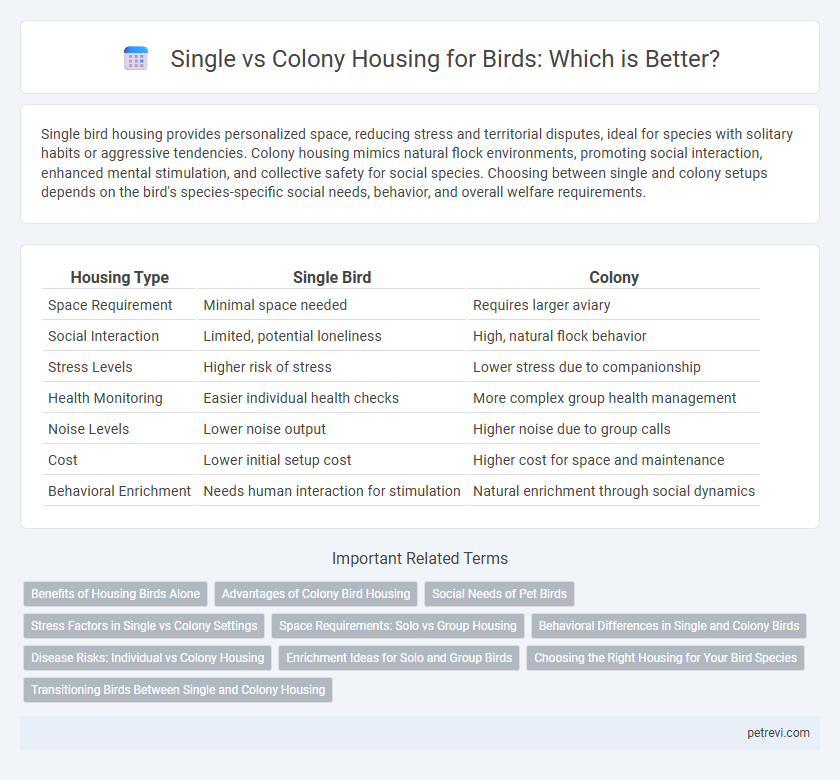Single bird housing provides personalized space, reducing stress and territorial disputes, ideal for species with solitary habits or aggressive tendencies. Colony housing mimics natural flock environments, promoting social interaction, enhanced mental stimulation, and collective safety for social species. Choosing between single and colony setups depends on the bird's species-specific social needs, behavior, and overall welfare requirements.
Table of Comparison
| Housing Type | Single Bird | Colony |
|---|---|---|
| Space Requirement | Minimal space needed | Requires larger aviary |
| Social Interaction | Limited, potential loneliness | High, natural flock behavior |
| Stress Levels | Higher risk of stress | Lower stress due to companionship |
| Health Monitoring | Easier individual health checks | More complex group health management |
| Noise Levels | Lower noise output | Higher noise due to group calls |
| Cost | Lower initial setup cost | Higher cost for space and maintenance |
| Behavioral Enrichment | Needs human interaction for stimulation | Natural enrichment through social dynamics |
Benefits of Housing Birds Alone
Housing birds alone reduces stress and aggression, promoting a calm environment that supports better health and longevity. Solo housing allows for individualized care, ensuring precise monitoring of diet, behavior, and medical needs. This setup also minimizes competition and the spread of diseases common in colonies, enhancing overall bird welfare.
Advantages of Colony Bird Housing
Colony bird housing promotes natural social behaviors and enhances mental stimulation by enabling birds to interact freely within a group. This environment supports improved breeding success and reduces stress levels compared to solitary confinement. Group housing also facilitates efficient space utilization and easier monitoring of collective health dynamics.
Social Needs of Pet Birds
Pet birds exhibit diverse social needs, with some species thriving better in single housing while others require colony environments for optimal well-being. Birds like parrots and finches often benefit from colony living, which provides social interaction, mental stimulation, and natural behaviors critical to their health. Conversely, solitary birds may experience stress or aggression in group settings, making individualized housing necessary to meet their emotional and psychological needs.
Stress Factors in Single vs Colony Settings
Birds housed individually often experience heightened stress levels due to isolation, leading to behavioral issues such as feather plucking and increased anxiety. In colony settings, social interaction reduces stress by fulfilling natural flocking instincts, but overcrowding can trigger aggression and competition for resources. Proper management of space, enrichment, and social dynamics is crucial to minimizing stress in both single and colony bird housing environments.
Space Requirements: Solo vs Group Housing
Single bird housing typically requires less space, around 2-3 cubic feet per bird, ensuring individual comfort and reducing stress. Colony bird housing demands significantly more space, approximately 10-12 square feet per bird, to accommodate social interactions and prevent overcrowding. Proper spatial allocation in group housing promotes natural behaviors and minimizes territorial disputes among birds.
Behavioral Differences in Single and Colony Birds
Single birds often exhibit increased stress and anxiety due to isolation, leading to repetitive behaviors and reduced vocalizations. Colony birds display complex social interactions, such as cooperative foraging, hierarchical structuring, and mutual grooming, which promote mental stimulation and overall well-being. Behavioral differences highlight the importance of social environment on bird psychological health and adaptive behaviors.
Disease Risks: Individual vs Colony Housing
Individual bird housing minimizes disease transmission by isolating pathogens and preventing direct contact between birds, reducing the risk of outbreaks. Colony housing increases exposure to infectious agents due to close proximity and shared resources, leading to higher chances of respiratory infections and parasites spreading rapidly. Effective sanitation and quarantine protocols are essential to manage disease risks in both single and colony bird housing systems.
Enrichment Ideas for Solo and Group Birds
Solo birds benefit from enrichment like interactive toys, mirrors, and foraging puzzles that stimulate mental activity and prevent loneliness. Colony birds thrive with naturalistic setups including multiple perches, communal feeding stations, and cooperative play objects that encourage social interaction. Providing species-specific enrichment tailored to solitary versus group living enhances overall bird welfare and reduces stress-related behaviors.
Choosing the Right Housing for Your Bird Species
Choosing the right housing for your bird species depends on its social behavior and space needs; solitary birds like canaries thrive in individual cages, while social species such as budgerigars require spacious colony aviaries to promote natural interaction and reduce stress. Proper housing size, enrichment, and safety measures tailored to the bird's physical and psychological needs ensure optimal health and well-being. Selecting appropriate materials and cage design also supports species-specific behaviors like perching, nesting, and flight.
Transitioning Birds Between Single and Colony Housing
Transitioning birds between single and colony housing requires careful monitoring of their behavior and stress levels to prevent aggression or social isolation. Gradual acclimation through visual and auditory exposure before direct interaction helps birds adjust to new social dynamics. Providing ample space, resources, and escape routes minimizes conflict and supports a smooth transition for bird health and well-being.
Single vs Colony for Bird housing Infographic

 petrevi.com
petrevi.com